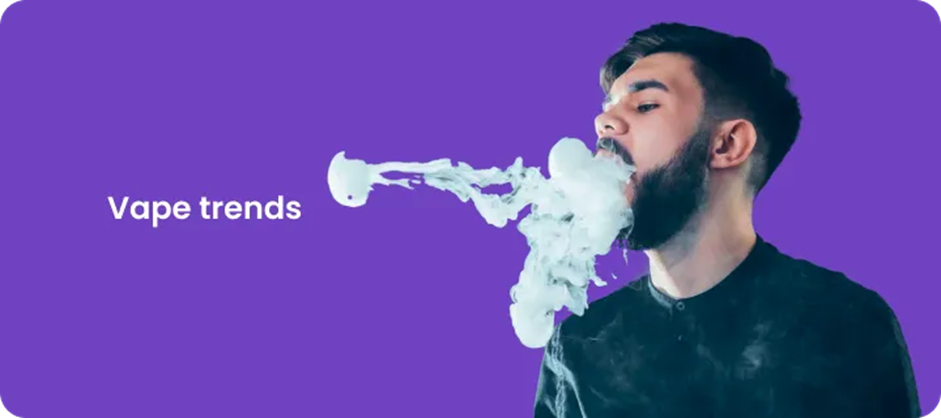The vape industry has experienced significant growth, evolving daily with improved advancements. This growth has been fueled by its perception as a harm-reduction alternative to traditional smoking. Users’ preferences are constantly changing. Initially, the focus was on nicotine delivery; however, factors such as flavour variety, device technology, and environmental impact are becoming increasingly important.

The vape industry has experienced significant growth, evolving daily with improved advancements. This growth has been fueled by its perception as a harm-reduction alternative to traditional smoking. Users’ preferences are constantly changing. Initially, the focus was on nicotine delivery; however, factors such as flavour variety, device technology, and environmental impact are becoming increasingly important.
Vape Trends

In 2025, vaping trends will increase demand for disposable vapes, reusable kits, new vape devices, and pod vape kits.. Companies producing quality reusable vapes are likely to substantially increase sales, driven by heightened environmental awareness among consumers seeking more sustainable and technologically advanced vaping options.
1. The Rise and Fall of 2ml Disposables
With introducing the disposable vape ban set for 2025, significant changes in the market for 2ml disposables are likely. Single-use vapes will be prohibited from sale in the UK starting June 1, and a temporary influx of products at reduced prices is anticipated as manufacturers and retailers clear their stock before the ban takes effect.
2. A Boom in Reusable Vapes and Vape Kits
There has already been a noticeable increase in the demand for reusable vapes and the number of available options. This trend is driven by the upcoming ban on disposables and a growing number of industry experts and consumers seeking more environmentally friendly vaping options including vaping accessories like grinders from sharpstone usa. Users can expect many refillable and rechargeable alternatives to disposable products, particularly reusable big puff vapes and pre-filled pod kits. A significant rise in traditional 2ml pre-filled pods and compatible devices is anticipated at the beginning of the year.
3. Flavour Consolidation and Consideration
Other producers and retailers are encouraged to follow the lead of industry leaders by moving away from exciting flavours that may appeal to individuals under 18. In light of the upcoming Tobacco and Vapes Bill, regulations restricting the sale of sweet flavours, such as candy and dessert varieties, are expected. Now is an opportune moment for the industry to focus on consolidating flavours and highlighting those that cater to more mature tastes.
4. Short Fills Set to Become a Specialist Range
With the introduction of the Vaping Products Duty, which imposes a flat excise rate of £2.20 per 10ml of e-liquid, as outlined in the Autumn Budget 2024, significant changes in the
e-liquid market are anticipated. Shortfill products are likely to be among the most drastically affected
Vaping Community: A network of support

Vaping communities consist of individuals who share a common interest in vaping, whether for smoking cessation, recreational use, or as a hobby. These communities can be found both online and offline, providing spaces where users exchange knowledge, discuss products, and share their experiences. As 2025 unfolds, the vaping industry—and the community it supports—stands at the forefront of innovation, health, and connection.
Whether users are new to vaping or experienced enthusiasts, this year offers opportunities to explore, improve, and engage.
Online Vaping Communities- The internet has enabled vaping communities to flourish, providing platforms for vapers to connect regardless of their location. On Reddit, popular subreddits like
r/electronic_cigarette allow users to share product reviews, troubleshooting advice, and industry news. Facebook groups offer private and public spaces for discussions, product sales, and regional vaping updates. YouTube influencers produce content from device reviews to coil
building and e-liquid mixing tutorials. Dedicated vaping forums, such as E-Cigarette Forum (ECF) and Planet of the Vapes, facilitate structured discussions with threads for beginners, advanced users, and advocacy topics. These online spaces are vital for exchanging information and
updating vaping trends.
Offline Vaping Communities- In-person vaping communities convene in vape shops, conventions, and advocacy groups. Vape shops function as local hubs where vapers can test products, receive personalised recommendations, and interact with like-minded individuals. Many shops
organise events, competitions, and promotional gatherings. Vape conventions, such as Vape Expo UK and ECC (Electronic Cigarette Convention), bring together manufacturers, influencers, and consumers to showcase new products and discuss industry developments. Advocacy
groups like CASAA (Consumer Advocates for Smoke-Free Alternatives Association) and the
Vaping Advocacy and Education Project (VAEP) focus on educating the public and policymakers about vaping to protect consumer rights and prevent restrictive regulations.
Benefits of Vaping Communities – Vaping communities offer numerous advantages, including
support for individuals transitioning from smoking, guidance on proper device usage, and access
to unbiased product reviews. These communities promote education on vaping safety, covering proper battery handling and selecting high-quality vape liquid. Moreover, they serve as social spaces for vapers to engage in activities like cloud-chasing competitions and coil-building
tutorials. Beyond social interaction, these communities play a critical role in advocacy, ensuring that vapers remain informed about regulatory changes and possess a voice in policy
discussions.
Challenges Facing Vaping Communities-Despite their benefits, vaping communities encounter significant challenges. Misinformation and stigma surrounding vaping often lead to public
misunderstanding and negative media portrayals. Regulatory restrictions, such as flavour bans and limitations on online sales, threaten accessibility and consumer choice. Additionally, social media platforms impose prohibitions and restrictions on vaping-related content, complicating efforts for communities to share information and educate users. Concerns about counterfeit
products and unregulated e-liquids also pose safety risks, highlighting the necessity for reliable community-driven guidance.
Vaping communities, both online and offline, play a crucial role in supporting vapers, educating consumers, and advocating for fair regulations. These communities foster a sense of belonging and empowerment, ensuring users access to accurate information and a platform for sharing
their experiences. Although these communities face regulatory and social challenges, their
impact on the vaping industry remains significant, shaping trends, promoting responsible vaping practices, and cultivating a global network of enthusiasts.
Influencers

Social media influencers are increasingly shaping public perceptions of vaping, playing a crucial role in both anti-vaping and pro-vaping narratives. Governments and health organisations
leverage influencers to highlight the health risks of vaping and promote cessation while vaping brands and enthusiasts use influencer marketing to attract new users. This dynamic illustrates the influential role of social media in influencing behaviours, particularly among young people.
Anti-Vaping Campaigns-Governments and public health organisations recognise that traditional anti-smoking campaigns are less effective at reaching younger demographics. Consequently,
they turn to social media influencers to disseminate messages about the risks of vaping and nicotine addiction. Influencers participating in these campaigns frequently share personal
stories, scientific facts, and emotional appeals to discourage vaping among young audiences.
The Influence of Social Media-Social media platforms like Instagram, TikTok, and YouTube are powerful tools for shaping perceptions around vaping. These platforms function as
battlegrounds for both anti-vaping and pro-vaping messages. Studies indicate that exposure to tobacco-related content on social media increases the likelihood of young people experimenting with vaping.
Regulations and Enforcement- In response to concerns about the impact of vaping content, social media platforms and regulatory agencies have taken steps to curb the promotion of
e-cigarettes. Instagram and Facebook have banned direct advertisements for vaping products, restricting how companies can market their devices. However, many brands continue to exploit loopholes by collaborating with influencers who post vaping-related content, often under the
guise of personal use rather than paid promotion.
Final thoughts
Vape culture has transformed into a global phenomenon shaped by changing trends, social media influencers, and close-knit vaping communities. Initially regarded as a smoking alternative, vaping has evolved into a lifestyle with its subcultures, encompassing cloud-chasing competitions and DIY e-liquid mixing. However, alongside its increasing popularity, vaping has faced heightened scrutiny due to health concerns, regulatory restrictions, and its appeal to
younger audiences. Vape trends continue to develop, influenced by technological advancements, shifting consumer preferences, and regulatory changes. The industry has swiftly adapted to meet user demands, transitioning from bulky box mods to the widespread popularity of sleek pod systems and disposable vapes. The growing interest in nicotine-free vaping, CBD-infused
e-liquids, and sustainability efforts reflects the trends that arise from both consumer awareness and legislative pressures.
Social media influencers play a crucial role in shaping public perceptions of vaping, both positively and negatively. Some influencers promote vaping as a lifestyle, showcasing new
devices and flavours. In contrast, others take part in anti-vaping campaigns that highlight the risks of nicotine addiction and lung health issues. This duality has turned social media into a battleground for competing narratives, requiring brands, health organisations, and regulatory bodies to adapt their strategies to engage younger audiences effectively continuously.
Vaping communities, both online and offline, remain essential to the industry. These spaces provide vapers with a sense of belonging, opportunities for knowledge-sharing, and advocacy
efforts. Online platforms such as Reddit, YouTube, and vaping forums facilitate the exchange of product reviews, troubleshooting tips, and regulatory updates. In offline settings, vape shops, expos, and advocacy groups foster connections among vapers and work diligently to protect
consumer rights. However, these communities also encounter challenges, including social media
bans, misinformation, and increasing government regulations that impact accessibility and
industry growth. As the vaping industry evolves, stricter regulations, technological innovations, and ongoing public health debates will likely influence the future.




